|
|
|
|
| TLE Vulcan XM655 night shoot 2014 TLE Vulcan XM655 night shoot 2021 |
| Keeping Vulcan 655 Alive Wellesbourne Mountford July 2017 |
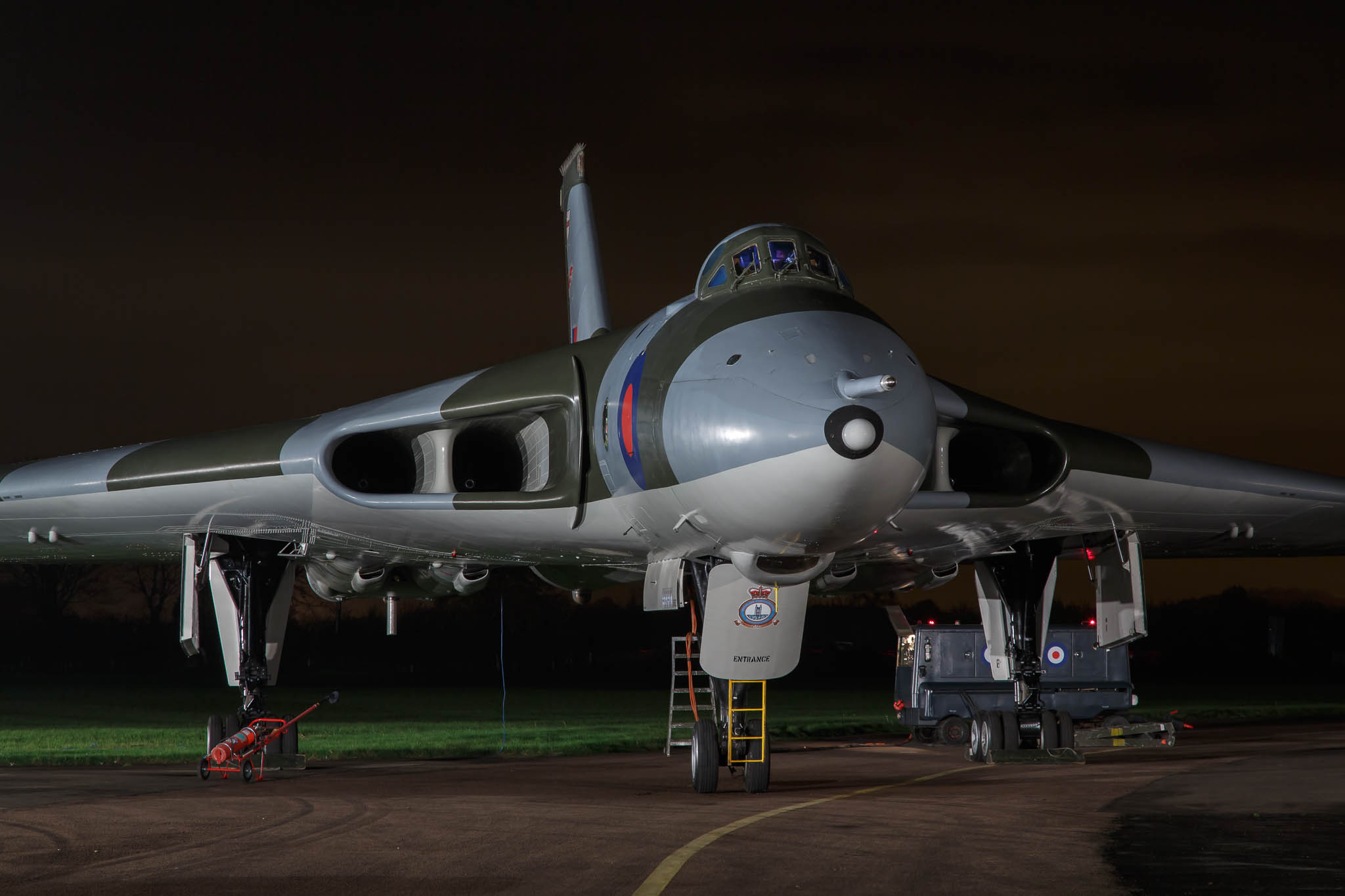 |
| TLE Night Photography Shoot |
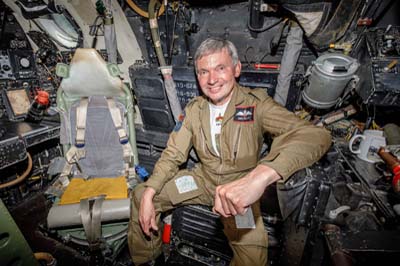 |
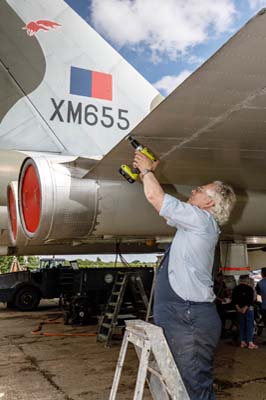 |
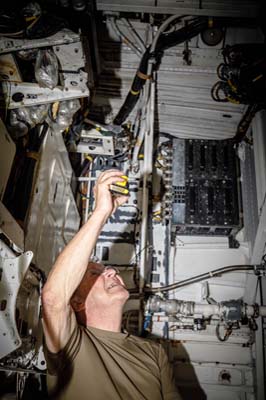 |
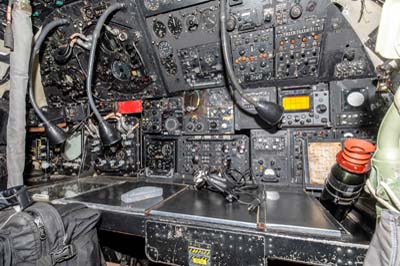 |
| Left to right: Wg Cdr Mike Pollitt sitting alongside the AEOs seat below the cockpit. "When I got back in the cockpit it was like sitting in your favourite armchair." He recalled the Cold War planned missions for low-level strikes at 80 feet (24.4m) to the Soviet Union he was trained on the Vulcan for; "We were told to head for Turkey after the strike but my plan was to head for Cyprus. I thought we had a chance of getting back. It was virtually a suicide mission in the 70s and eighties as they had improved their air defences". 655MaPS are preparing XM655 for a fresh paint scheme by buffing away using special non-damaging tools to remove any flaky paint. The 50+ year old XM655 has been repainted several times to keep the inevitable corrosion under control. The aircraft will maintain its 50 Squadron markings of two leaping greyhounds which was derived from their World War One call sign of Dingos and an insignia of the two greyhounds chasing a dingo. Len Hewitt experienced in Vulcan avionics frequently has to inspect and test the systems, here inside the bomb bay. "I came to Wellesbourne in 2009 just to take a look, as soon as I climbed the ladder to the cockpit I remembered the smell from 30 years ago" he said. The rear facing control panel where sat the; Navigation plotter and Nav’ radar operator and AEO. “It was one of the worst environments for aircrew, they were flying at low-level facing backwards in darkness with blinds over the small windows”. |
The new 655MaPS chairman
His association with 655MaPS started over 20 years ago when he was invited by David Thomas, the last Vulcan display pilot, to help out in the cockpit during ground runs and taxiing as they did not have anyone to sit in the right hand seat able to operate the controls and switches. “When I got back in the cockpit it was like sitting in your favourite armchair” says Mike Pollitt. Starting the engines is all done with flight reference cards, that was the easy bit but admitted remembering where the switches were was the hardest part of his return to the cockpit. Although the Vulcan was designed to operate from 9,000 foot (2,743m) runways, they only have 3,000 feet (914m) to work with at Wellesbourne. “The biggest skill required is not for the abortive take-off display but the manoeuvring the Vulcan on the narrow 150 feet [46m] wide runways and taxiways when 200 feet [61m] is what we used to have” says 655 display pilot Mike Pollitt. ”If I was to just use the nose wheel steering I would go off the side of the runway so I have to use differential breaking in to the turn before using the nose wheel”. This is practiced three times a year. “I used to pitch up as just a few times a year for events and cockpit tours, now it’s more like every three Saturdays in four”, says Mike Pollitt. “Today is an engineering day but still people will turn up hoping to be shown around, for £10 they can get a cockpit tour from me which is wonderful”. The 655MaPS team and the challenges they face Mike Pollitt runs a team of 25 who give up most of their Saturdays to maintain the aircraft, some with key skills. Eric Ranshaw worked on Olympus engine with Rolls Royce, together with Derek Powell they played a big part in the aircraft’s original refurbishment after it had been left to deteriorate for ten years up to 1994. Derek Powell has agreed to come back with Fred Bartlett to do another repaint later this year.
The members and helpers who work on 655 are not exclusively made up of retired aviators and technicians, there are also many younger helpers. The events coordinator Damaris Tapp, she brought her son Ben to help when he was ten, he is now taking his ‘A’ levels and has been a volunteer engineer for the last six years. He has been taught to drive the aircraft tug and is now a qualified crew chief. He will be outside the aircraft connected to the aircrew during our engine runs, coordinating all the ground equipment such as the Houchin ground power unit (GPU) and the Turbomeca Palouste air compressor which is basically a small jet engine used to start the engines. David McCulloch with 150 Squadron ATC based in Oxford has been supervising Air Cadets at Wellesbourne over the last seven years for at least one Saturday a month. The Air Cadets have previously jacked up the aircraft and have taken an engine out. “The goal is to get young people interested in engineering by working on this aircraft” says David McCulloch. Whilst 60 to 100 help out for ‘Wings and Wheels’, it’s just one staff supervisor per up to five cadets on maintenance days. Our ultimate aim is to get her 100% serviceable “It’s a continual refurbishment”, says Mike Pollitt. Recently they have been trying to get the H2S ground scanning radar system to work and also mend their auxiliary power unit. Earlier this year they had to fix the Vulcan’s emergency air brake motor.
Continued support Michael Littler is airport manager and a member of the family which owns Wellesbourne airfield and Vulcan. He is very supportive and shows an interest in what 655MaPS are doing. Despite continued talk of housing developments the airfield appears to be secure. “They have kindly said to us that the future of the aircraft is assured, even if the site is further developed with a loss of the runway”, says Mike Pollitt adding. “We would hope to secure a hangar for 655 but this would mean we could not start the engines. The aircraft could never be removed to another airfield because we could not put her back together again so she was able to taxi. The hydraulic and fuel lines for example were not designed to come apart”. A project for this year is to add two number one fuel tanks which the aircraft lacks, built from scratch by GKN. Without these tanks filled with fuel the aircraft’s centre of gravity is shifted towards the rear, the concern being with a lot of snow on the wings she would end up sitting on her tail. It is an endless task maintaining the Vulcan but Mike Pollitt says, “Many of our guys are in the 70s but still happy to pitch up, I am not concerned about the future. I am 67 and feel quite capable to taxiing her for the next five years”. With continued good management of 655MaPS and with the support of its owners the future of XM655 appears assured.
Vulcan B.2 XM655, 20 years of service From 1960 deliveries of the improved Vulcan B.2 were made featuring the more powerful Bristol Olympus 301 engines, a larger wing, an improved electrical system and electronic countermeasures (ECM). Some aircraft were modified to accept the Blue Steel missile however the final 28 B.2s including XM655 were only partially fitted to accept the Douglas GAM-87 Skybolt air-launched ballistic missile to be fitted one under each wing, Skybolt was to be cancelled in 1962. Of the 89 Vulcan B.2s built nine were converted for Maritime Radar Reconnaissance (MRR) role with the TFR removed. Six B.2s were converted to K.2 standard for air-to-air refuelling using a Hose Drum Unit (HDU) mounted in the tail cone and three bomb-bay drum tanks. XM655 was not selected for these modifications. Built at Woodford XM655 was delivered to RAF Cottesmore on November 23, 1964 to serve in a Wing consisting 9, 12 and 35 Squadrons which were tasked initially to operate in the high altitude free-fall bombing role with the ‘Yellow Sun’ Mk2 nuclear bomb. However before XM655 was delivered the role changed to low-level strike and she was delivered in the camouflage scheme to 9 Sqn. Later with 35 Sqn XM655 took part in a series of overseas bombing exercises to Malta (Luqa), Singapore (Tengah), United States (Offutt) and Canada (Goose Bay) in 1965 alone. On January 12, 1968 XM655 was transferred RAF Waddington Wing consisting of 44, 50 and 101 Squadrons and by 1975 included 9 Sqn. Her first year’s operations included low-level flying sorties to Germany (Wildenrath) with 44 Sqn and to Goose Bay (Ex Goose Ranger), Malta and Libya (El Adem) with 50 Sqn. In 1970 XM655 flew its first round-the-world trip to demonstrate and test the capability to re-inforce Singapore. The route taken for exercise ‘Sunflower’ was; Goose Bay, Offutt, McLellan, Hickham, Wake Island and Anderson to arrive at Tengah six days later. The return flight passed through; Gan, Masirah and Akrotiri. In 1983 the Wing was depleted and XM655 finished her flying days with 50 Squadron operating alongside Vulcan K.2s in the air defence role. With the 50 squadron due to disband in March 1984, XM655 was put up for disposal. |
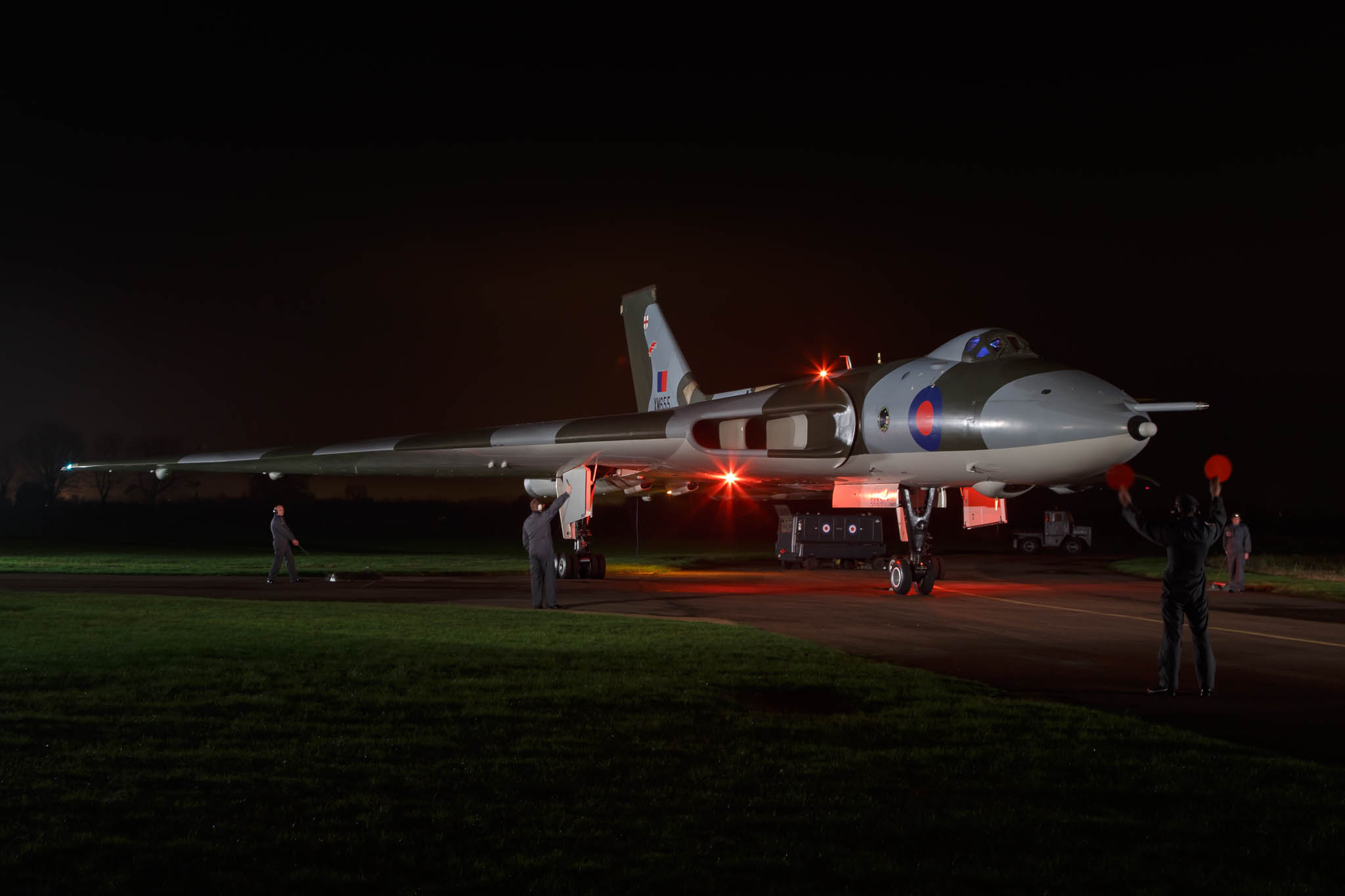 |
| XM655 resplendent in all her glory and repositioned on a taxiway during a Time Line Events night photoshoot. Re-enactors are used to recreate cameos of a Vulcan ready to scramble from an RAF base during the Cold War. XM655 set in a full state of 'ready to depart' with all her lights on and the ground crew chief giving her pilot directions from the taxi way. |